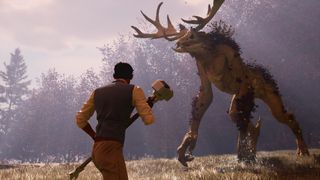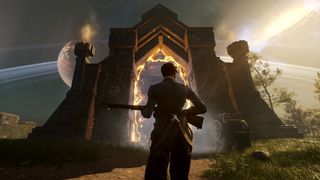
In the interests of time, I've been given some gear to help get me up to speed in Nightingale. According to game director (and Mass Effect veteran) Aaryn Flynn, it'll take 30-50 hours to get to the endgame in his new survival game, but as we only have two hours together, I've been granted enough clothing, weaponry, and food to get me there fast.
We've been geared out so that we can take a relatively easy run across Nightingale's varying Realms. After the tutorial has me rush through small versions of the Forests, Deserts, and Swamps that form the three major biomes of this 'gaslamp fantasy' survival game, we take a run across a desert, towards a distant tower that marks an important part of what Nightingale does in setting itself apart.
It's on that journey that the trouble starts. I'm not entirely sure what sets the Zombie-like bound off, but it's only a few moments before Flynn finds himself on the floor, downed by a creature with huge sweeping blades strapped to its arms. Still finding my feet, it's not long before I follow suit, but the rest of our party finishes off our enemies and helps us both up. Flynn is clearly puzzled, as this entire realm has been created via Nightingale's adjustable difficulty to be relatively easy for newcomers to get to grips with, but we continue on regardless.
Shortly after, we come to the tower, where procedural generation means anything could be waiting for us on its higher floors. Flynn charges ahead to see what he can find, only to get knocked down for a second time. He's helped back up, but now the Bound are charging down the stairs towards the rest of the group – and it's a chaotic fight, marked by an automotive 'Bishop' hovering ominously over proceedings. As I pick enemies off with the clunky 'click-POW' of my electrified shotgun, Flynn is trying to work out why this is proving such a challenge. It quickly becomes clear that this 'easy' realm is not so easy after all, as Nightingale's director flees down a flight of stairs having worked out that the power level of this realm is far higher than he expected. Eventually, all the Bound are dealt with, and we head to the top of the tower. Up there, we find the thing that truly sets Nightingale apart from other survival games.
A Nightingale sang at BioWare

Nightingale's internal philosophy relies on the idea of multiple Realms, dimensions that can be traveled between via portal generators. Playing different 'cards' into those generators means that you can shape portals in different ways, choosing the biome that you're heading for, but also adding modifiers to those biomes. You might choose to play a card that yields far more wood than normal from felled trees, or one that buffs your own strength to make combat easier.
At the top of the tower lies a machine that allows players to play those modifiers. Before Flynn can react, someone plays a Bloodmoon card, and the world around us seems to shatter, fractal golden shapes exploding outwards from the machine. When the scene settles, the sky is crimson, a moon staring chaotically down at us like something out of J.R.R. Tolkein's worst nightmare. A Blood Moon means that players will earn more resources when they kill enemies, but they'll take damage over time as a cost.
With a realm that's already more difficult than he intended, Flynn makes it clear that a Blood Moon isn't what we need right now, so he lets us experiment. Someone plugs in a card that makes a storm roll in – the fractals appear, dispelling the Blood Moon, and replacing it with roiling cloud. That drops the heat in the punishing desert biome we're exploring, but Flynn says that it's also useful for ensuring rain falls on your crops if you're farming. It'll also change a little every time – this time, the heavens opened on us immediately, but it might take a bit longer for the tempest to descend on other occasions.
Sign up to the GamesRadar+ Newsletter
Weekly digests, tales from the communities you love, and more
Refreshing as the rain might be, it's not particularly helpful in the desert, so Flynn plugs in another card. This time, it lowers the gravity, allowing us to leap from the top of the tower towards our next objective. What follows is a bizarre Poppins-esque scene, as our party descends from the tower, dangling from the umbrellas that act as gliders in Nightingale's Victoriana world.

Realmwalkers
The way that Nightingale's realms shift is genuinely impressive; it feels almost impossible for an idea this stylish to work as snappily as this. My concern is that it's buried too deep within Nightingale's more traditional survival trappings. Having been fast-forwarded through the hunting and gathering that tends to shape these games, I don't know how long it takes to start controlling the weather on a whim, but I do know that to get there, you'll need to collect plenty of sticks and plant fibers to create a tent and a fireplace, and that to stave off hunger you'll need to scoop up berries and cook them.
What that means is that Nightingale is, in many ways, the exact same survival game that you've played many times before, at least in several of the ways that will matter to a large proportion of players. That's not a bad thing – survival games are popular because people continue to enjoy what they have to offer, and Nightingale is a very, very pretty survival game, one that's comfortable in its deeply stylish aesthetic and does want to do something different with its endgame. Its challenge will lie in whether it can show that something off quickly enough to keep players going.
Arryn Flynn says he "wouldn't go back" to the way BioWare makes games after Nightingale.

I'm GamesRadar's news editor, working with the team to deliver breaking news from across the industry. I started my journalistic career while getting my degree in English Literature at the University of Warwick, where I also worked as Games Editor on the student newspaper, The Boar. Since then, I've run the news sections at PCGamesN and Kotaku UK, and also regularly contributed to PC Gamer. As you might be able to tell, PC is my platform of choice, so you can regularly find me playing League of Legends or Steam's latest indie hit.
Most Popular



